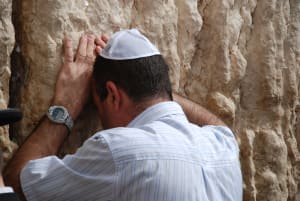9 things Israelis do on Yom Kippur, the Day of Atonement

Yom Kippur, the Day of Atonement, is the holiest day in the Jewish calendar, and Jewish people all over the world will participate in various ways. Even secular Jews often take part in observing this day, using it as a time of self-reflection, and seeking to put things right in their lives.
For many centuries, Jews have lived in countries that do not observe Yom Kippur, however, now that they have their own nation and the freedom to follow Jewish traditions, what does the Day of Atonement look like in Israel?
1. Fasting
The most prominent aspect of Yom Kippur is fasting. The Bible commands the people of Israel to “afflict” themselves (Leviticus 16:29), which is not exactly the same as fasting but is a command to humble ourselves in some way as we seek God’s atonement for our sins. Fasting is a good way to obey that command. It’s traditional to fast from all food, and even liquids for some, from sunset to sunset, starting the evening before and finishing at sundown on the day of Yom Kippur. Many religious Jews refrain from conjugal relations, applying lotions or oils, wearing leather footwear and even washing.
2. Wearing white
While the day is about seeking cleansing and holiness, it’s traditional to wear white. For some, wearing white is a reminder of burial shrouds, and the fact that we will ultimately meet God to give an account for the way we have lived our lives. Many also prepare a table with a white tablecloth and candles for the same reason, even though there will be no food for the duration of Yom Kippur. In Israel, you will see people dressed in white on their way to the synagogue, which brings us to the third tradition.
3. Going to synagogue
Just as churches brace themselves for a large influx of extra visitors at Christmas time, so synagogues are much more full on Yom Kippur than just about any other time of year. There are services on the evening before the day of Yom Kippur and also during the day itself, with specific prayers and blessings, as well as Bible passages and encouragement. Psalm 24 is part of the reading for example, and there is plenty of opportunity to reflect.
4. Kol Nidre liturgy
One of the more familiar aspects of the Jewish liturgical tradition of Yom Kippur is known as Kol Nidre. Kol Nidre means “all vows” and is the first prayer to be declared on Yom Kippur Eve. Its primary purpose is to release oneself from vows we may have made unintentionally. It is set to beautiful music and marks the beginning of Yom Kippur.
5. Blessing children
Before Yom Kippur begins it’s traditional to bless the children in the family. The blessing for a son is that God would make them like Ephraim and Menashe, which is to say very fruitfully, like the two sons of Joseph. For a daughter, the blessing is that God would make them like Sarah, Rebekkah, Rachel and Leah. It is also common to say the priestly Aaronic blessing over children at this time: “The Lord bless you and keep you; the Lord make his face to shine upon you and be gracious to you; the Lord lift up his countenance upon you and give you peace. So shall they put my name upon the people of Israel, and I will bless them” (Numbers 6:24-27).
6. Confessing sins
It seems obvious that on Yom Kippur, when Israel is seeking atonement for sin, that confession of sin is part of the deal. However, the depths to which the confession reaches in the traditional prayers are profound and extremely thorough. Every aspect of life is covered! Ultimately, after an exhaustive list of possible areas of sin, the prayer is that “the sin we committed before You knowingly and unknowingly, for all of these, God of pardon, pardon us, forgive us, grant us atonement.”
7. Riding bikes
Driving cars is frowned upon in Israel on Yom Kippur, and the streets are almost empty. It’s a strange sight to see busy highways empty (and silent), but once a year, it happens. And every year, on Yom Kippur, people make the most of the opportunity to ride bikes on the freeways and otherwise busy roads. Israelis stroll, ride, or take their scooters to the empty streets on Yom Kippur, the quiet gentleness of the day is a beautiful contrast to our otherwise hectic lives.
8. Kapparot
One of the more peculiar aspects of Yom Kippur that has developed is the tradition of “kapparot.” In the Bible, several sacrifices are called for, in particular, two goats: one on which the sin of the house of Israel is imputed, which is sacrificed, and the “scapegoat” which is sent off into the desert, representing how God takes our sin as far as the east is from the west.
However, in lieu of animal sacrifices, the tradition of swinging a chicken, or a bag of money, over one’s head has become commonplace in many communities and is known as “kapparot” or “atonements.”
9. Breaking the fast
After a long 24-hour period (25 hours to be on the safe side), Yom Kippur prayers draw to a close and the day is ended with a blast of the shofar.
While it is a solemn day of repentance with no food, it’s still seen as a feast of sorts. It’s traditional to have a special celebratory meal together once Yom Kippur ends.
Isaiah 43:25 is part of the readings during the day, where God tells Israel: “I, I am he who blots out your transgressions for my own sake, and I will not remember your sins.”
On Yom Kippur, God gave the whole house of Israel the opportunity to press the “reset” button and to experience forgiveness as a whole community. That is something worth celebrating!

Jo Elizabeth has a great interest in politics and cultural developments, studying Social Policy for her first degree and gaining a Masters in Jewish Philosophy from Haifa University, but she loves to write about the Bible and its primary subject, the God of Israel. As a writer, Jo spends her time between the UK and Jerusalem, Israel.
You might also like to read this:














